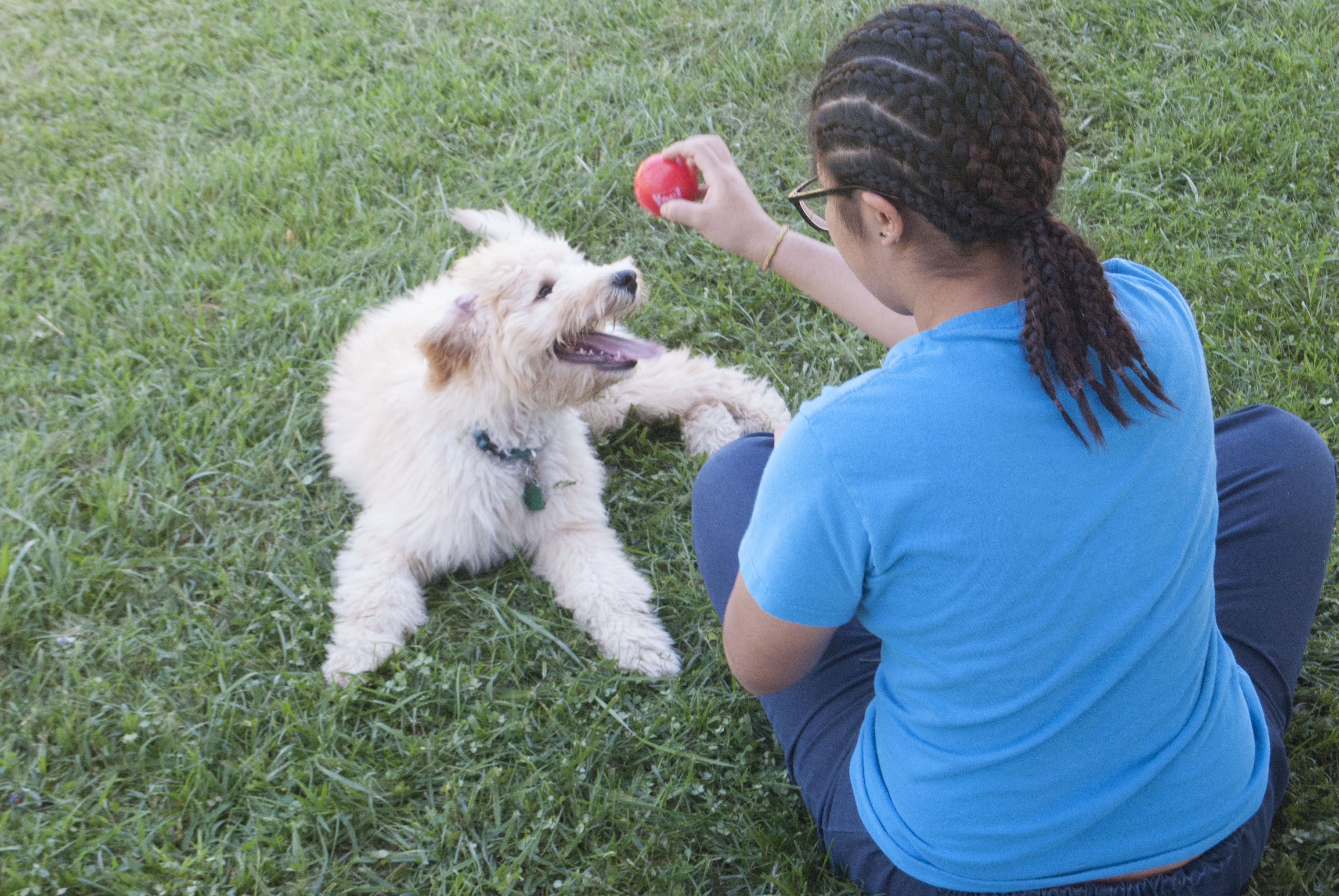LAUREL, Maryland––When visitors and staff members walk through the front door of Thomas JS Waxter Children’s Center, they’re greeted by sign-in sheets, hand-held metal detectors and, now, a bouncing, fluffy yellow pup named Clay. Affectionately described by staff as Waxter’s “welcoming committee,” he is a 20-week-old Miniature Goldendoodle.
Clay and an 8-month-old Bernedoodle, Bayr, tend to the emotional needs of youth held at two Department of Juvenile Services secure detention centers.
Resident teens at Waxter, a 42-bed girls’ facility, and the Western Maryland Children’s Center in Hagerstown, a 24-bed boys’ facility, now have designated time with a puppy during recreation, and access to them during challenging counseling sessions.
Residents at the all-girls facility have taken to Clay. They tap on glass windows to get his attention as he barks and bounds around the dayrooms and bolt toward him, shouting his name in excitement as he bursts out onto the yard.
The teens consider Clay, named after the facility’s location on Red Clay Road in Laurel, not just a lovable mascot, but a form of therapy. A young woman from Prince George’s County, who was in the facility before his arrival in July, says he’s helped her and other girls learn to cope.
“Kids who couldn’t figure out how to keep calm or get through have bonded through Clay,” she told Capital News Service. “He just listens.”
Medical and mental health experts have indicated that animal-assisted therapy, or pet therapy, benefits their patients.
The National Alliance on Mental Illness issued a statement on the merits of pet therapy, saying that it “can reduce symptoms of anxiety, depression, fatigue and pain for many people,” and a 2018 Critical Care journal article written by rehabilitation and ICU experts at Johns Hopkins suggested that animal-assisted intervention within specific critical health care populations can promote rehabilitative behavior.
The pilot program started in late spring after the department’s Secretary of Support Services, Lynette Holmes, began an initiative to bring a dog therapy program to the state’s facilities. She approached Bill Pickrel, the assistant director for the department’s Western region, and the two designed a plan based on another already implemented at youth facilities in Oregon.
Pickrel plays a crucial role in the program not only as its advocate but as a donor. His wife is a puppy breeder at a company run out of their home called TLC by the Lake Standard Poodles and Doodles. American Kennel Club-certified, the business specifies in different types of “doodles,” or poodle mixes. The pair donated both puppies to the department.
Pickrel and his wife watched both Clay and Bayr grow up in their home, vetting them to ensure that they had the right personality and temperament for the action-packed environments. They used the Volhard Puppy Aptitude Test — a widely respected puppy personality exam that looks into traits like touch, sound and sight sensitivity, as well as their willingness to be socially dominated by a human.
Finding the right pup for the culture of each facility was essential for Pickrel. He said that for Waxter they were looking for something playful and cuddly — a “teddy bear type”; for Western Maryland Children’s Center, a “big boy” with a laid-back attitude.
“You have to find where the puppy’s gonna fit best and not disrupt,” said Pickrel, “so the dynamics at one facility are different than the dynamics at the other.”
Though the puppies were donated to the department, they don’t live in their designated facilities. At the end of a long day, Bayr goes home with Jalicia Brown, a regional social work supervisor at the boys’ facility, and Clay leaves with Trina Lyles, the assistant superintendent at Waxter. Pickrel said that this arrangement is based on the relationship between police officers and their K-9 dogs.
Ensuring the puppies had a steady home was key. Department Communications Director Eric Solomon said that making sure that each puppy had a handler to go home to was “the important thing.”
Each handler has given up part of their free time outside of the facilities for obedience training and vet visits — all paid for by the state for an estimated cost of around $700 per pup so far.
“I’ve been taking my work home with me for years,” said Lyles, who found her start in the Department of Juvenile Services as a direct care staffer at Waxter 21 years ago. “Anything that’s going to benefit the lives of these little girls…I have to do it.”
Lyles advocated for the expansion of the program after seeing Bayr’s success with the boys in the Western Facility. She said she approached the girls and staff to see if they’d be willing to help her care for him before committing, and that everyone has kept up with their promise.
The girls help to clean up after him while he’s on the unit, and staff will periodically come up and snag him for a walk or some pets over the course of the day.
“No one comes to see me ever,” jokes Lyles, whose office now includes a dog bed, cage and smattering of chew toys.
The program is intended to remain a pilot for now as the department gauges the benefits and viability of expanding it to other facilities.
Clay, despite all of his doggy accouterments, settled down for a break in his busy afternoon at Lyles’ feet, under her desk.

